Arbinger Institute's Blog, page 4
August 1, 2024
5 leaders’ secrets to create a high-performing culture
Do you ever look at industry leaders and wonder: “What’s their secret?” We’ll give you a hint: It’s about more than having the best product or the most funding. According to a recent study, 94% of executives and 88% of employees believed that workplace culture directly impacted the overall success of their business. So, how can leaders create a high-performing culture? Building a remarkable company takes more than just ping-pong tables and nap pods; it’s about cultivating a strategic environment where people can thrive.

In this curated list, we’ll delve into the often-overlooked practices that successful leaders leverage to create high-performing cultures. You’ll have the unique opportunity to tap into the wisdom of real leaders who’ve nurtured incredible organizations, all thanks to powerful cultural shifts. These aren’t flashy gimmicks but rather core principles established by The Arbinger Institute that have helped propel countless organizations to the top. It’s time to ditch the surface-level perks and unlock the true potential of your team.
1. Treat people like people Leader: Scott O’Neil, CEO | Harris Blitzer Sports & Entertainment
Leader: Scott O’Neil, CEO | Harris Blitzer Sports & EntertainmentScott O’Neil’s secret weapon: treating everyone with respect! It sounds simple, but it’s powerful. A high-performing culture isn’t about blind positivity; it’s about setting clear expectations and holding people accountable. This includes providing constructive feedback and fostering open communication. Employees who feel valued and trusted are more likely to go the extra mile.
Why this works:Treating people with respect builds trust. Employees who feel safe sharing ideas, asking questions, and making mistakes are more likely to be innovative and engaged. A culture of respect also reduces micromanagement and empowers employees to take ownership of their work.
2. Embrace differences, achieve results Leader: Louise Francesconi, Division President | Raytheon
Leader: Louise Francesconi, Division President | RaytheonLouise Francesconi highlights the power of diversity and inclusion in the workplace. A high-performing culture thrives on different perspectives and experiences. When you empower employees from various backgrounds to collaborate and share ideas, you unlock a wellspring of creativity and innovation. Imagine a marketing team brainstorming with a data analyst, a graphic designer, and a social media expert. Each person brings a unique perspective, leading to well-rounded and effective campaigns.
Why this works:Fostering an inclusive environment where everyone feels valued can help you tap into the full potential of your workforce, which can lead to a significant competitive advantage in the marketplace.
3. Ask the golden question – “how can I be helpful?” Leader: Monique Davis, Deputy Superintendent
Leader: Monique Davis, Deputy SuperintendentMonique Davis emphasizes the importance of effective communication. A high-performing culture thrives on open dialogue and active listening. Instead of pointing fingers, leaders should focus on solutions and how they can support their teams. Imagine a salesperson missing their quota. In a blame-oriented culture, the manager might criticize the salesperson’s performance. However, in a high-performing culture, the manager would have regular check-ins, offer coaching, and explore potential roadblocks together.
Why this works:Open communication builds trust and psychological safety. When employees feel comfortable asking for help and providing feedback, it fosters collaboration and problem-solving.
4. Leverage tools for conflict resolution Leader: Hilary Provinse, Executive Vice President | Berkadia
Leader: Hilary Provinse, Executive Vice President | BerkadiaWhen you have an “eat-what-you-kill” mentality in a business, motivation runs high, and so do fears. Hilary Provinse faced this challenge when building a high-performing culture that embraced community and collaboration despite the organization’s commissions-based, competitive sales environment. By shifting their mindset and focusing on the company’s ultimate goal rather than individual conquests, they could strike a balance. What once were debates transformed into collaborative conversations focused on the end-all goal: getting more market share from clients! With communication frameworks prioritizing conflict resolution, team members were encouraged to embrace new perspectives, recognize strengths and weaknesses, and ultimately achieve better results.
Why it works:Clear communication is the foundation for collaboration. It keeps everyone aligned on goals and expectations, reducing confusion. Open sharing allows teams to identify strengths and weaknesses, enabling effective task delegation and support. This also fosters early problem-solving and builds trust. When team members feel safe to express themselves, they’re more likely to be creative and seek help.
5. Allow your company mission to ring true Leader: Terry Lim, COO | Pet Food Express
Leader: Terry Lim, COO | Pet Food ExpressWhat happens when purpose drives a business instead of numbers? You create a high-performing culture where people are driven to perform for the betterment of all. The leadership team at Pet Food Express gives power to its people by entrusting them to make decisions and take actions that keep the company’s vision alive. This level of trust and encouragement has created a community where people communicate comfortably, avoid micromanaging, and leverage expectations to ensure balanced growth.
Why it works:When you listen to and support your team, encouraging them to explore solutions that align with the company mission, you create an environment of ownership and accountability. This trust fosters a culture where individuals feel valued and empowered, leading to increased innovation and productivity. By prioritizing open communication and shared goals, you establish a high-performance culture where people and productivity thrive.
Cultivate high-performance culture by investing in peopleClear communication is the foundation for collaboration; it keeps everyone aligned on goals and expectations, reducing confusion. Transparency allows teams to identify strengths and weaknesses, enabling effective task delegation and support. This also fosters early problem-solving and builds trust. When team members feel safe to express themselves, they’re more likely to be creative and voluntarily seek help. This open dialogue fuels innovation by leveraging diverse perspectives. No one is perfect, communication allows teams to learn from mistakes and continuously improve together.
Ready to unlock the potential in your team? Download our culture report to learn more tactics for cultivating a high-performing culture built on respect, inclusivity, open communication, and trust. It’s the surest path to a thriving organization!
The post 5 leaders’ secrets to create a high-performing culture appeared first on Arbinger.
July 24, 2024
Identifying self-deceptive behaviors at work [Quiz]
We all experience self-deceptive behaviors at work from time to time. It’s a normal human tendency to explain away mistakes, avoid uncomfortable situations, or hold onto positive self-images. However, in the workplace, self-deception can hinder your growth, damage relationships with colleagues, and ultimately limit your success.
This quiz will help you identify areas where you might be engaging in self-deceptive behaviors at work. There are no right or wrong answers—the goal is to be honest with yourself and consider how you typically approach different work scenarios.
By recognizing your tendencies towards self-deception, you can take steps to be more objective in your thinking and responsive to challenges. This can lead to improved communication, stronger relationships with colleagues, and ultimately, better performance.
Identifying self-deceptive behaviors at work quiz You’re feeling overwhelmed with your workload. How do you handle it?Delegate tasks appropriately and ask for help when needed. Tell yourself you can handle it all and keep pushing yourself beyond your capacity. Avoid taking on new tasks and hope no one notices you’re struggling. Take on more work to prove yourself, even if it means sacrificing quality. Powered by Typeform #outlook a{padding:0}body{margin:0;padding:0;-webkit-text-size-adjust:100%;-ms-text-size-adjust:100%}table,td{border-collapse:collapse;mso-table-lspace:0pt;mso-table-rspace:0pt}img{border:0;height:auto;line-height:100%;outline:none;text-decoration:none;-ms-interpolation-mode:bicubic}p{display:block;margin:13px 0}@media only screen and (min-width:480px){.mj-column-px-640{width:640px !important;max-width:640px}.mj-column-per-100{width:100% !important;max-width:100%}}.moz-text-html .mj-column-px-640{width:640px !important;max-width:640px}.moz-text-html .mj-column-per-100{width:100% !important;max-width:100%}.mj-column-px-640{width:100% !important;max-width:640px}/*!sc*/data-styled.g1[id="sc-global-juhJZJ1"]{content:"sc-global-juhJZJ1,"}/*!sc*/Additional self-reflection prompts
Think about your recent experiences at work and consider your typical responses to the following scenarios:
Giving and receiving feedback: How do you react when you receive critical feedback? Do you actively listen and seek ways to improve, or do you become defensive or downplay the feedback’s importance? When giving feedback to others, are you honest and constructive, or do you find yourself sugarcoating criticism or avoiding difficult conversations altogether?Conflict resolution: When disagreements arise with colleagues, how do you approach the situation? Do you avoid conflict altogether, even if it means letting important issues fester? Or do you tend to get defensive or aggressive when faced with opposing viewpoints?Taking responsibility for mistakes: How do you handle your own mistakes? Do you readily admit them and take ownership, or do you find yourself blaming others or minimizing the severity of the error?Work-life balance: Do you struggle to set boundaries between work and personal life? Are you constantly checking emails or working late, even when it’s not strictly necessary?Openness to learning: Are you receptive to new ideas and challenges, or do you find yourself clinging to familiar methods and resistant to change?Remember: Acknowledging your own self-deceptive behaviors at work isn’t about being perfect; it’s about building self-awareness, shifting your mindset, and constantly striving for improvement. By reflecting on these prompts and being honest with yourself about your tendencies, you’re taking the first step towards greater self-awareness and a more successful work life.
The new fourth edition of Arbinger’s best-selling book, Leadership and Self-Deception, explores how to break free from self-deceptive behaviors, transform relationships, and unleash results. Pre-order a copy today.
The post Identifying self-deceptive behaviors at work [Quiz] appeared first on Arbinger.
July 17, 2024
5 self-deception examples in the workplace
We’ve all been there: brilliant ideas shot down, leaders preaching work-life balance while pulling all-nighters. These frustrating situations often stem from something deeper: self-deception. Self-deception isn’t always malicious; usually, it’s a subconscious way to protect our egos or avoid discomfort. However, it can create a ripple effect in the workplace, impacting team dynamics, project outcomes, and overall company culture.
What is self-deception?Have you ever lied to yourself or tricked yourself into normalizing an unhealthy habit? That’s self-deception! It’s a common human behavior often used to avoid facing uncomfortable truths or protect self-esteem. In the workplace, self-deception can create big problems that hold back personal and professional growth. It can block effective communication in teams by spreading false stories and distorted views. When team members aren’t honest with themselves or others, they’re unlikely to share their real thoughts, concerns, and ideas. This lack of openness can cause misunderstandings, reduce trust, and ultimately harm collaboration and innovation within the team.
By recognizing self-deception in the workplace, you can start to understand and overcome it. This awareness paves the way for better communication, stronger teams, and greater company success.
When thinking about self-deception at work, consider the following questions:
 The different faces of self-deception
The different faces of self-deceptionAs you read through the following self-deception examples, see if any of them resonate with your workplace experiences or those of your colleagues. By identifying these behaviors, you can take steps to create a healthier and more productive work environment.
The overconfident workerThe overconfident worker believes their skillset is unmatched, superior. This form of self-deception takes the shape of misplaced confidence. It can lead them to dismiss feedback, reject learning opportunities, and overlook mistakes.
Example: Sarah, a seasoned programmer, consistently rejects code reviews from her colleagues, believing her work is flawless. This prevents her from catching errors and creates tension within the team.Impact: This behavior stalls professional growth, introduces potential errors in work, and frustrates colleagues who have to compensate for those mistakes. The team’s efficiency and morale can suffer as a result.Solution: Encouraging a culture of continuous learning and humility can help reduce overconfidence. Leaders can set an example by openly accepting feedback and demonstrating that seeking help is a strength, not a weakness.The perfectionist procrastinatorThe perfectionist sets unrealistic expectations for themselves, leading to procrastination and missed deadlines due to fear of failure.
Example: David, a graphic designer, avoids starting a project because he’s overwhelmed by the need to create something perfect. This delays the project timeline and creates stress for both him and his team.Impact: This act of self-deception leads to increased stress, missed opportunities, and potential damage to team projects. The constant delay can erode trust in the team’s ability to deliver on time.Solution: Promoting an outward mindset and celebrating progress over perfection can help team members with this behavior. Leaders can break down projects into manageable tasks and set realistic deadlines, providing support and encouragement throughout the creative process.The busy martyrThe disengaged bystander convinces themselves that they have no power to influence positive change or address problems within the company culture.
Example: John notices a toxic work environment developing but tells himself he can do nothing to change it. This not only makes him feel powerless but hinders the team’s ability to address the issue.Impact: This behavior leads to missed opportunities for improvement, decreased employee morale, and a stagnant work environment. The lack of action can cause negative behaviors, further damaging the workplace culture.Solution: Be bold and empower employees to voice their concerns; accountability is the first step in counteracting disengagement. Leaders should create open channels for feedback and actively work to implement positive changes based on employee input.The “yes man”The “yes man” agrees to unrealistic deadlines or tasks without considering availability, leading to stress, missed expectations, and potential resentment.
Example: During a brainstorming session, Michael agrees to take on an overly ambitious project without considering his workload or the team’s resources. This sets them up for failure and frustrates the team, who has to pick up the slack.Impact: This behavior leads to burnout, frustration for colleagues who must cover for the “yes man,” and potentially damaged relationships with superiors who feel misled. Unrealistic commitments can derail projects and harm the team’s credibility.Solution: Honest communication and realistic goal-setting are essential in the workplace. Leaders should create an environment where team members feel comfortable discussing their limits and negotiating deadlines, ensuring that commitments are achievable and aligned with available resources. How to avoid self-deception at work
How to avoid self-deception at workWith a few key strategies, we can dismantle self-deception at work. The first step? Cultivate self-awareness. Encourage employees to reflect regularly on their behaviors and attitudes to help them identify biases. By unveiling these blind spots, they can begin to recognize areas where they might be deceiving themselves.
Open communication is another weapon in the fight against self-deception. Create a safe space where team members can share thoughts and concerns freely. Establish ground rules for respectful communication, actively listen to others, and focus on solutions rather than blame. Regular feedback sessions, both positive and constructive, are also crucial. Honest communication sheds light on opportunities for improvement, allowing individuals to course-correct before self-deception takes root.
Finally, invest in the architects of a team’s culture: the leaders. When leaders embrace an outward mindset, they inspire others to do the same. This creates a ripple effect of transparency that dismantles self-deception and paves the way for a more productive and fulfilling work experience for everyone.
Break free from self-deceptionSo, how can we shatter self-deceptive patterns? Leadership holds the key! By providing the necessary support and resources, leaders can empower their teams to recognize and challenge self-deceptive behaviors, ultimately fostering a healthier and more productive work environment. Arbinger’s best-selling book, Leadership and Self-Deception, offers a powerful roadmap for fostering a culture of honesty and empathy within a team.
The book reveals how self-deception, in the form of blind spots and biases, shapes everyday work dynamics. We often dismiss the impact of our actions on others, deflecting blame and hindering collaboration. Leadership and Self-Deception demonstrates how leaders can confront these habits, transforming workplaces into environments where genuine collaboration and innovation thrive.
Are you ready to unlock your full leadership potential? Pre-order the newest edition or download a free preview of Leadership and Self-Deception. Discover how to break free from self-deception and create a more productive and fulfilling work experience for yourself and your team.
 hbspt.cta.load(23346030, 'e8e8921b-32b3-45a0-8bfb-267e317e2e5d', {"useNewLoader":"true","region":"na1"});
hbspt.cta.load(23346030, 'e8e8921b-32b3-45a0-8bfb-267e317e2e5d', {"useNewLoader":"true","region":"na1"}); The post 5 self-deception examples in the workplace appeared first on Arbinger.
July 10, 2024
Introducing the new fourth edition of Leadership and Self-Deception
The leadership classic, Leadership and Self-Deception, is back and better than before. This brand-new fourth edition has been updated with fresh insights, examples, and cutting-edge strategies to help you navigate today’s ever-changing workplace landscape. Read on to learn more about the new edition of Leadership and Self-Deception and why you should pre-order a copy.
Overview of Leadership and Self-DeceptionTranslated into over 30 languages, Leadership and Self-Deception has sold over 3 million copies, making it one of the top 50 leadership books of all time. This best-selling book, facilitates a transformational, insight-rich experience for readers by introducing Arbinger principles in an authentic, inclusive, and accessible narrative structure. It also offers a glimpse into how an outward mindset can help transform organizations.
However, as much as readers love this leadership classic, a lot has changed in the world since its original publication in 2000. While each successive edition has added additional resources for readers, we came to believe that a fundamental rewrite was required to make this classic relevant and resonant to readers today. That’s why we’re excited to announce the release of the fourth edition of Leadership and Self-Deception.
What’s new in this editionTo build upon the book’s legacy, the new edition better helps readers by:
Updating the setting to align to the modern workplace.Incorporating a diverse group of characters in a meaningful way. Refining the presentation and explanation of Arbinger principles.Incorporating practical guides to apply the tools on a personal, team, and organization-wide level.Revamping end materials to be more helpful in utilizing the book, applying principles, and identifying next steps.The fresh, modern setting addresses contemporary topics that have not been covered in previous editions. This edition highlights a more expansive array of experiences, representation, and relatability that truly showcase the challenges people are currently facing at home and in the workplace.
Prior editions of the book relied heavily on the metaphor of “the box” as shorthand for the experience of self-deception. The idea of “out of the box thinking” has gradually come to be understood as unrestrained creativity by traditional views. To avoid confusion and more clearly address self-deception, a new subtitle, The Secret to Transforming Relationships & Unleashing Results, reflects the core value the book provides to readers.
In addition to these changes, we have crafted an entirely new Group Discussion Guide for readers. The guide will help you and other readers immediately apply the ideas in the book and take the next step of discussing what they are learning with others in their organizations. Readers are also invited to join the Arbinger Book Club to find application support with other readers who are trying to apply the ideas in their own lives and organizations.
What types of challenges does this book help solve?Like previous editions, the fourth edition of Leadership and Self-Deception addresses workplace issues such as culture, efficiency, effective leadership, and all people-related dysfunction that plague relationships, hindering organizational results.
Told through an engaging story, this book reveals the ways we blind ourselves to our true motivations and unwittingly sabotage our efforts to achieve success and rebuild broken relationships. The new edition introduces main characters who represent more modern gender roles and a broader array of racial/ethnic diversity that previous editions lacked. Also, this new edition incorporates personal and family dynamics in the key characters’ lives that we think you will find relatable. These changes equip leaders and employees alike to make humanity in their workplace their greatest asset rather than their greatest obstacle.
Get a preview of Leadership and Self-Deception chaptersThoughtfully divided into three distinct parts, comprising twenty-seven chapters, this new edition explores the complexities of self-deception, thus simplifying the concept in the reader’s mind.
You can get an exclusive look at the new edition by downloading our free sample chapters.
 hbspt.cta.load(23346030, 'e8e8921b-32b3-45a0-8bfb-267e317e2e5d', {"useNewLoader":"true","region":"na1"});
hbspt.cta.load(23346030, 'e8e8921b-32b3-45a0-8bfb-267e317e2e5d', {"useNewLoader":"true","region":"na1"}); Beginning with a clear depiction of the character’s individual perspective, Part I: A disease of perception, illustrates the way in which perceptions part from reality, often leading to contention. Followed by an empowering yet humbling lesson on accountability, Part II: Lies that blind us, allows readers to recognize individual flaws while simultaneously leaving space for change and growth. The book concludes with Part III: The vision to lead, teaching readers to work with others, allowing them the space to address their own self-deception and change accordingly.
Pre-order your copy of Leadership and Self-DeceptionThis refreshing and captivating update will leave you not only motivated but also prepared to handle the difficult people-related issues in your organization. We cannot wait for you to get your hands on the newest edition of Leadership and Self-Deception and transform your workplace!
Be among the first to get a copy of Leadership and Self-Deception, Fourth Edition: The Secret to Transforming Relationships and Unleashing Results.
Click here to learn more and pre-order a paperback or Kindle version. The book will be released on August 27, 2024.
The post Introducing the new fourth edition of Leadership and Self-Deception appeared first on Arbinger.
June 4, 2024
How to measure the impact of organizational culture
Explore the many ways organizations can measure the impact of culture transformation.
Improving your culture may logically sound like the “right” thing to do, but convincing your organization to invest in learning and development initiatives can be challenging without first understanding how they will impact company performance.
Setting effective goals for culture transformation involves a systematic approach. Measurement is key to ensuring you’re both maximizing your investment while also staying on track. Start by thinking about your goals and how you want to evaluate them.
If you’re wondering how to assess the impact of your current culture or culture transformation efforts, here are five areas that drive culture transformation and some suggested metrics to prove ROI.
AccountabilityEngagementCollaborationPsychological safetyInclusionTip: Download our Team Development Scorecard to measure the impact and ROI of transforming your organizational culture.
AccountabilityLow accountability among your employees is a major problem that leads to poor performance and low morale among your teams.
The root cause of most workplace challenges is that people naturally focus on themselves—prioritizing their own needs and challenges without thinking about other team members’ goals, objectives, or obstacles.
A team with low accountability is constantly behind on projects, missing team targets, and limiting each others’ ability to learn and develop.
By shifting mindsets to foster a culture of accountability, employees take ownership of their actions and how they impact others, leading to increased levels of trust and collaboration among team members.
Measure these accountability metrics to help prove your ROI:
Task completion ratesMeeting attendance & participationTimeliness of reportingIssue resolution timeResource utilizationGoal achievementEmployee self-assessment scoresFeedback response timeLearning & development progress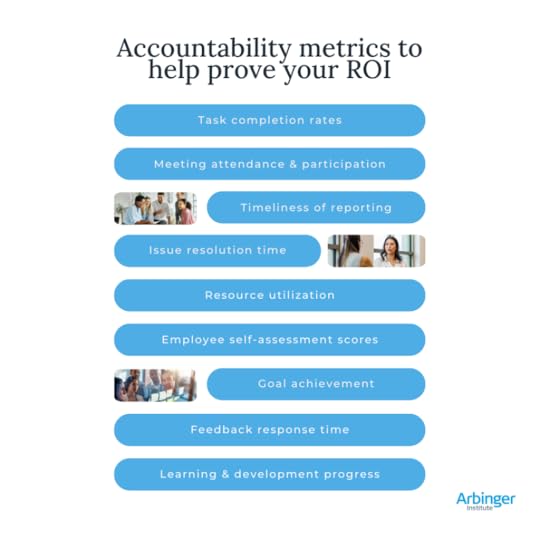 Engagement
Engagement The success of your company is driven by the engagement and productivity of your employees.
Gallup defines employee engagement as the involvement and enthusiasm of employees in their work and workplace. Engaged employees are enthusiastic, proactive problem-solvers who consistently deliver high productivity.
On the other hand, disengaged employees lack motivation, prefer to work alone, and may avoid their responsibilities.
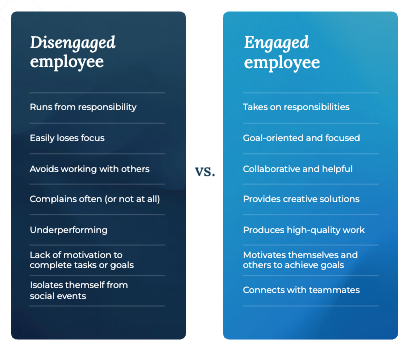
Gallup reports that an average of 17.2% employees are disengaged. They’ve also estimated that the cost of a disengaged employee is roughly 34% of their salary. So, given the same example above, a 100-person organization that provides an average salary of $60,000 could have a total disengaged cost of $350,000 per year.
Use this formula to get an idea of what employee disengagement is costing your organization:
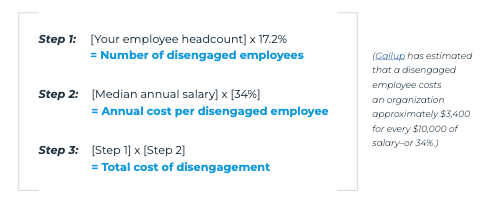
This figure highlights the costs of disengagement, but beyond the bottom line, it also undermines organizational cohesion, dampens innovation, and accelerates turnover.
Improving your organizational culture has a direct impact on the engagement and productivity of your employees.
A Gallup study showed that employees who feel strongly connected to their organization’s culture are 3.7x as likely to be highly engaged at work. And companies with a highly engaged workforce are 21% more profitable than those with disengaged staff.
Measure these engagement metrics to help prove your ROI:
Job satisfaction scoresEmployee turnover & retention rateTraining & development completion ratesWorker productivityJob tenureAbsenteeism ratesPerformance ratingsEmployee trust in leadershipEmployee and peer recognition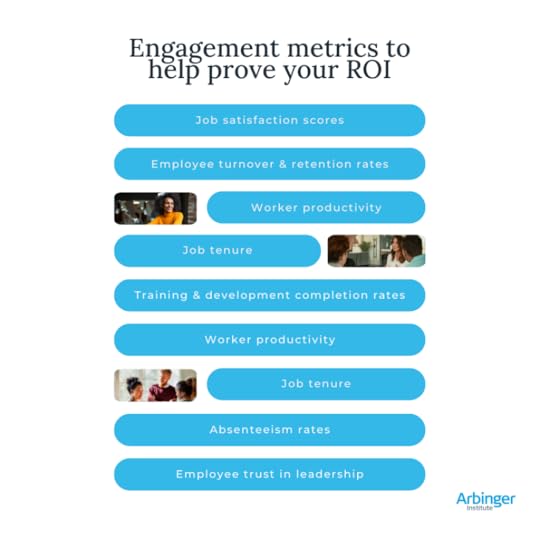 Collaboration
CollaborationMeaningful collaboration leads to more innovative solutions and creative problem-solving.
But a negative organizational culture can stifle cross-team collaboration leading to low productivity, knowledge sharing, and overall employee engagement.
Efforts to transform your culture can lead to a sense of unity and camaraderie among team members, creating a positive work environment and improving employee morale and satisfaction.
Not only that, but better collaboration can enhance productivity and efficiency by streamlining processes and facilitating effective communication, contributing to the organization’s overall success and competitive advantage.
Measure these collaboration metrics to help prove your ROI:
Team productivity metricsCommunication frequencyCollaboration tool usageFeedback and recognitionKnowledge sharingEmployee survey resultsCross-team project participationCustomer satisfactionTeam member contributions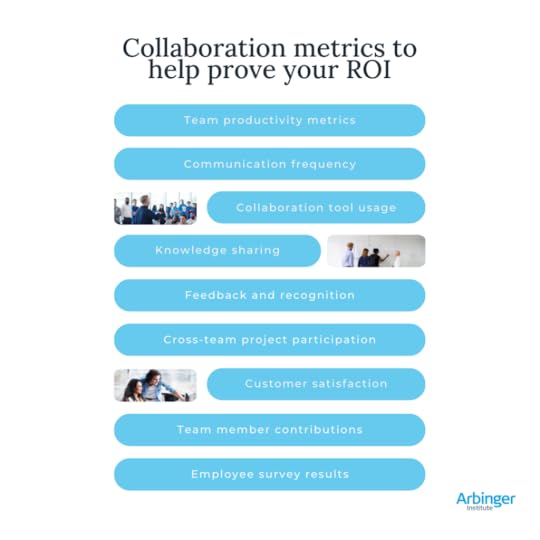
According to a Google study, psychological safety is the most important factor in effective teams. Unfortunately, negative organizational culture can lead to low employee engagement, retention, and advocacy.
In an economy where it’s becoming increasingly hard to find and attract great talent, organizations without a strong culture struggle to compete.
According to new benchmarking data from the SHRM, the average cost per hire is nearly $4,700. But, many employers estimate the total cost to be three to four times the position’s salary. That means a role paying $60,000 annually, could cost $180,000 to fill.
On the opposite end, Gallop reports that U.S. businesses are losing a trillion dollars every year to voluntary turnover. Mercer reported that the average voluntary turnover rate among US businesses in 2022 was 24.7%.
So, a 100-person organization that provides an average salary of $60,000 could have turnover and replacement costs of up to $4.4 million per year.
Fostering psychological safety at work encourages open communication and the expression of ideas without fear of judgment, leading to increased innovation and creativity within teams.
It promotes a supportive and inclusive work environment where individuals feel valued, respected, and empowered to take risks and contribute their best work. This, in turn, boosts employee morale, engagement, and overall well-being.
A Gallup study showed that employees who feel strongly connected to their organization’s culture are 5.2X as likely to recommend their organization as a great place to work and 55% less likely to be watching for other job opportunities.
Measure these psychological safety metrics to help prove your ROI:
Employee feedbackIncident reporting ratesEmployee survey resultsAnonymous reporting utilizationEmployee turnover ratesConflict resolution effectiveness360-degree feedback resultsLeadership sentimentEmployee advocacy Inclusion
InclusionIt’s crucial for people to do their best work that they feel valued, welcomed, respected, represented, and heard—and that they fully belong.
Citigroup conducts regular studies on the cost of resisting DEI in the workplace and it continues to rise as organizations ignore the impact of exclusion.
Their 2020 study showed that in two decades, the loss for US businesses was $16 trillion dollars. That’s taking into account the healthcare costs associated with physical, emotional, and mental stress that many employees face, which impacts employee performance and limits their potential.
Inclusion has a direct correlation to your culture. They rank at the top of the list of initiatives that have the greatest impact on improving an organization’s culture, with 53% of decision-makers and strategic leaders reporting so.
A recent Arbinger study also found that nearly two-thirds (63%) of organizations that prioritize inclusion initiatives have retention rates of 60% or higher. They were also over 2X more likely to see significant increases in revenue during the last year. (42% vs 18%)
Bottom line—when employees feel valued, respected, and accepted for who they are, you’ll see increases in morale, motivation, and commitment to the organization.
Measure these inclusion metrics to help prove your ROI:
Representation in leadershipInclusion survey resultsPromotion rates by demographicEmployee resource group participationSocial demographics of employeesAudit of accessibility accommodationsDiscrimination complaintsInclusive language usage auditTurnover rates by demographic Your culture is constantly evolving
Your culture is constantly evolvingIt’s clear that culture can impact your organization in many ways. Some can be seen on a spreadsheet, while others affect us in ways that are more difficult to measure.
The bottom line is that your culture has a major impact on your organization’s success. Oftentimes, most workplace challenges are related to people and culture challenges. As much as we want to look to a new strategy, process, or even new talent, without building a strong culture and shifting the mindset of your workforce, you’ll likely continue to have the same issues.
By tracking these metrics and asking the right questions regularly, you can build a stronger, more innovative, and more successful organization.
 hbspt.cta.load(23346030, 'd743e15b-e020-435b-88ac-4302adc3b558', {"useNewLoader":"true","region":"na1"});
hbspt.cta.load(23346030, 'd743e15b-e020-435b-88ac-4302adc3b558', {"useNewLoader":"true","region":"na1"}); The post How to measure the impact of organizational culture appeared first on Arbinger.
May 15, 2024
Unleashing performance: How adaptability at work helps improve team performance
A positive company culture is no longer a luxury, it’s a strategic advantage. It equips organizations to adapt, innovate, and thrive regardless of their challenges. In fact, our data shows that fostering adaptability at work creates a proactive and confident workforce, which is critical to success.
Arbinger, in partnership with Ascend2 Research, surveyed 440 professionals across different regions of the globe to discover what the most successful company cultures look like, and how impactful culture is in improving team performance. We’ve compiled our findings in our 2024 workplace culture research report: Unleashing Performance: How Adaptable Cultures Drive Sustainable Results.
In this blog, we’ll:
Share an overview of Arbinger’s 2024 workplace culture research reportExplore proven strategies to improve team performanceHighlight why is adaptability important in the workplaceProvide a link to download the full reportThree ways to improve team performanceOur report found that when people are prioritized and highly satisfied with their company culture, we see more collaborative and efficient environments where employees view others’ goals, objectives, and challenges as important as their own.
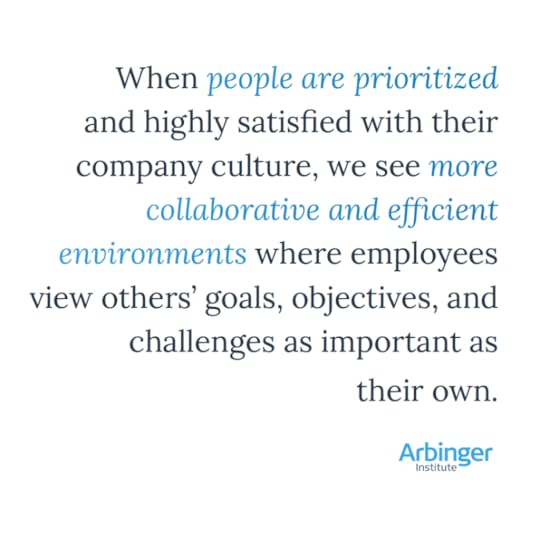
Our findings reveal that investing in leadership development, team performance, and inclusion are three key areas that directly impact satisfaction with culture and a working environment.
In fact, companies that prioritize leadership, employee engagement and accountability, and inclusivity are 11x more likely than others to have employees who are very satisfied with their company culture.
In the report, we answer: “Why is adaptability important in the workplace?” as it relates to these three areas:
Developing leaders who empower othersIn our research, we found that less than one-third (29%) of professionals surveyed report that their company places a high priority on developing leaders who empower others. However, leaders who empower their teams foster a culture of trust and respect, promoting team engagement and collaboration.
Just take a look at these results from organizations that prioritize leadership development compared to all others:

If these results don’t speak to the importance of leadership development, this stat will: Arbinger found that professionals working for organizations prioritizing leadership development are nearly 4.5x more satisfied with their organization’s culture than others.
Drive team performance through engagementThe bottom line is that engaged employees are more satisfied, efficient, and collaborative than their less-engaged counterparts. Our research found that organizations promoting the development of engaged and accountable employees have significantly higher culture satisfaction rates than organizations that don’t prioritize employee engagement as heavily (61% say they are very satisfied with their company culture, compared to 14% of all others).
We also found that when it comes to improving workplace performance, focusing on engagement and accountability can:
Improve efficiency. Companies that prioritize improving team performance are over 5x more likely than others to have achieved excellence in efficiency, according to professionals surveyed (53% vs 10%). Improve communication and collaboration. Overall, only 21% rate communications and collaboration at their organization as excellent. However, those who work at organizations prioritizing employee development are nearly 5x more likely to rate communications and collaboration as excellent than all others (48% vs 10%). Embed inclusion into the core of culture
Embed inclusion into the core of cultureCreating inclusivity and belonging within a company culture is essential for ensuring diversity in perspectives, which fuels innovation, drives engagement and productivity, and promotes psychological safety among employees.
Nearly all professionals surveyed report that investments in inclusion efforts have increased or stayed the same since 2020, with 43% reporting an increase and 47% saying they remain unchanged. Just 4% report decreases.
In our research, we found that those who work for organizations that prioritize inclusion are significantly more likely to describe their fellow employees as reliable, collaborative, adaptable, communicative, accountable, inclusive, proactive, and self-aware.
Look at the comparison and its impact on workplace performance here:
 Why is adaptability important in the workplace?
Why is adaptability important in the workplace?Our research indicates that a strong and adaptable company culture breeds organizational success. Just 23% of professionals surveyed describe their company’s organizational health as strong and adaptable, but this group exhibits significantly more positive attitudes and results compared to their counterparts in less-than-ideal environments.
An adaptable workplace culture sets employees up for success. Our data shows that those in strong and adaptable environments are about 110% more comfortable taking on new challenges than others. That stat alone should prove the importance of adaptability at work!
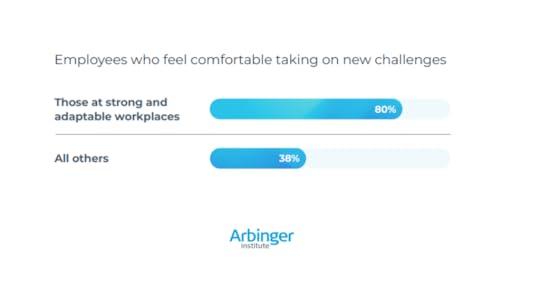 Unleash performance with adaptability at work
Unleash performance with adaptability at workIf you enjoyed the stats highlighted in this blog post, there are plenty more where that came from! In our 2024 Workplace Culture Research Report, we dive deep into the importance of adaptability at work (and ultimately, the undeniable value of a strong workplace culture). Download your copy today.
 hbspt.cta.load(23346030, 'd743e15b-e020-435b-88ac-4302adc3b558', {"useNewLoader":"true","region":"na1"});
hbspt.cta.load(23346030, 'd743e15b-e020-435b-88ac-4302adc3b558', {"useNewLoader":"true","region":"na1"}); The post Unleashing performance: How adaptability at work helps improve team performance appeared first on Arbinger.
May 14, 2024
Fostering a positive company culture: 76ers CEO on leading leaders
Is your company culture thriving, or just surviving? Scott O’Neil, CEO of the Philadelphia 76ers, offers a powerful perspective on building a workplace culture where people can excel: Culture is defined by what you celebrate and what you tolerate. It’s the sum of all the little things you do as a company.
Can you create a great place to work while still being high-performance-driven? Absolutely, says O’Neil. The key? Treat people like people.
That means setting clear expectations, holding people accountable, and providing constructive feedback. But it also goes beyond mechanics. It’s about taking a genuine interest in your employees as individuals and creating a space where open communication fosters continuous improvement.
Watch this short video featuring members of the 76ers team sharing how they build a positive company culture:
O’Neil believes that when you surround your employees with the right people, resources, and trust, they’ll thrive. And when you show that you authentically care about them, you’re well on your way to building a truly wonderful company culture.
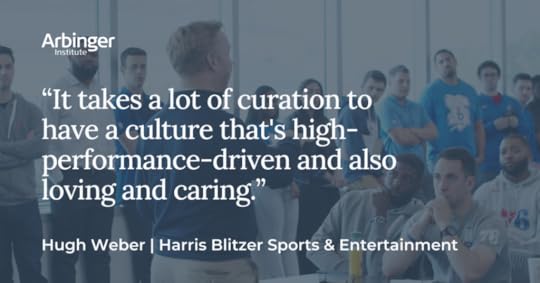
Here are some takeaways from Scott O’Neil’s on creating a positive company culture of leaders:
Focus on people: Company culture is all about the people you employ.Set expectations and hold people accountable: Establish a clear vision of success and hold everyone to those standards.Provide feedback: Open communication is key to growth, and feedback should be used to improve team development and performance. Show you care: Take a genuine interest in your employees’ well-being, both personally and professionally.Trust your team: Empower your employees with the tools, resources, and trust they need to succeed.By following these principles, you can create a company culture that is both positive and productive.
76ers CEO on creating culture of leading leadersScott O’Neil’s leadership philosophy is all about building a strong company culture. Even when faced with challenges, like taking a job with a then-struggling team, Scott focused on the people. He saw it as an opportunity to develop a positive work environment from the ground up.
This focus on employee well-being continued throughout his career. A personal setback with his own company, HoopsTV, taught him the importance of investing in his employees. He implemented a comprehensive onboarding process that goes beyond just the basics. New hires receive not just office supplies, but also welcome packages for their families, information about the area, and a copy of Leadership and Self-Deception that Scott himself reads with them. This personalized approach fosters a sense of community and belonging right from the start.
Scott emphasizes the importance of being present and engaged, a concept he calls “be where your feet are.” (He actually wrote the book on this!) He encourages employees to put their phones down and focus on the work at hand. This focus on mindfulness and connection is a core tenet of the thriving workplace culture he has cultivated. The results speak for themselves: the Philadelphia 76ers have been named “the best place to work in Philadelphia” for three years running. By prioritizing his employees’ experience, Scott O’Neil has not only fostered a positive company culture but also led the team to renewed success.
The post Fostering a positive company culture: 76ers CEO on leading leaders appeared first on Arbinger.
May 13, 2024
Culture Transformation Flywheel: Making culture change in an organization actually stick
Creating a high-performing organization goes beyond superficial changes; it takes a profound culture shift. Arbinger’s Culture Transformation Flywheel offers a strategic approach to operationalize and sustain this shift, addressing the root cause of negative work cultures affecting most organizations today.
What does culture transformation actually mean?The performance of organizations is intrinsically linked to their culture, yet most struggle with toxic work environments.
On the surface, employees recognize that they should put aside their personal motives and focus on the greater good of the team. But their mindset is internally focused. As a result, following through with the right behaviors seems almost irrational.
We call this “self-deception.”
“It blinds us to the true causes of problems, and once we’re blind, all the “solutions” we can think of will actually make matters worse. Whether at work or at home, self-deception obscures the truth about ourselves, corrupts our view of others and our circumstances, and inhibits our ability to make wise and helpful decisions.”
—Leadership and Self-Deception
According to Gallup, half of the U.S. workforce is “not engaged” at work — meaning they do the minimum required and are psychologically detached from their job. You may also know this as “quiet quitting,” a phenomenon that’s leading to $1.5 trillion in corporate losses every year.
On the other hand, companies with highly engaged employees outperform their peers by 147% and employees who feel their voice is heard are 4.6x more likely to perform their best work.
To build that type of high-performing organization, you need to fundamentally shift how employees approach their work and relationships with each other. Transforming these relationships is the not-so-secret strategy for driving culture transformation.
Why the current approach to culture transformation is brokenDespite the evident need for change, a staggering 70% of culture transformations fail.
The traditional approach, centered on “fixing” behaviors, creates a counterproductive cycle. The Vicious Cycle of Fixing Behaviors.

Organizations try to push culture change by imposing new programs that aim to “fix” behaviors. Unsurprisingly, employees resist. And any positive changes are based on compliance, not commitment.
Training programs are delivered, but not embraced, further worsening the time and cost of negative culture. As a result, changes don’t last because they merely address behaviors, not the underlying mindset driving them.
No matter how much you invest in these programs, they are destined to fail if met by resistant team members. Like planting seeds in toxic soil—growth becomes impossible.
That’s why you need a holistic approach that gets to the root of the problem—leadership and employee mindset.
A holistic approach to culture transformation that’s actually sustainableThe Culture Transformation FlywheelSo how are some organizations able to transform their culture and make it actually stick? The key lies in adopting a holistic perspective with a primary focus on mindset.
Lasting change doesn’t come from simply buying more tech, increasing budgets, or changing processes. It starts with a people-centric approach. An investment in people-oriented solutions to spark innovation, engagement, and productivity in your workforce.
Success depends on the interconnected relationships of your people, and to impact that, you need a shift in mindset, operationalized in three ways:
Developing leaders who empower others Developing engaged and accountable employeesUnlocking potential with an inclusive workplaceTogether, these initiatives create a Culture Transformation Flywheel. A continuous, self-reinforcing cycle that leads to lasting culture change.
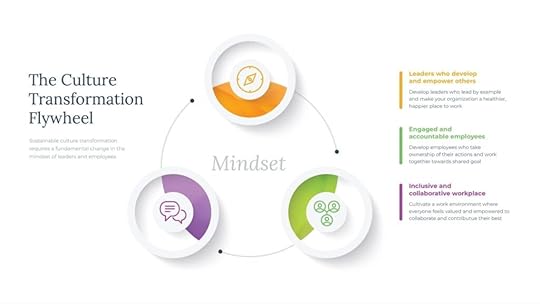 The role of mindset in culture transformation
The role of mindset in culture transformationBeliefs, values, and attitudes (aka. our mindset) influence our behavior. In many ways, you can think of your culture as the output of the collective mindset of your organization.
So, if you want to change your culture, you need to break the vicious cycle of trying to fix behavior, and, instead, address the mindset that drives it.

A McKinsey study found that organizations are 4x more likely to succeed in their transformation efforts when they address mindset.
That means focusing on training programs that aim to shift employee mindset and help them see themselves and others differently.
The rest of this article will break down the Culture Transformation Flywheel into more actionable steps, providing a roadmap for organizations to embark on their transformative journey.
Develop leaders who empower othersCreating a supportive workplace starts with leaders who know how to help others shine. Organizations must invest in developing leaders who can expand their influence, encourage teamwork, and build trust. By setting the right cultural tone at the leadership level, organizations can create a healthier, happier, and more successful place to work.
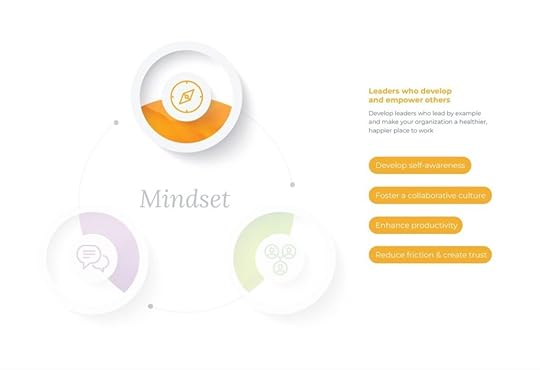 Develop self-awareness
Develop self-awarenessSelf-awareness is the cornerstone of building high-performing, accountable teams. A leader who understands their own strengths, weaknesses, and biases can navigate challenges more effectively and inspire trust. This self-awareness fosters open communication, where team members feel comfortable sharing ideas and holding each other responsible.
Leaders who are self-aware can also delegate effectively, empowering their teams to take ownership and maximize their potential. Ultimately, a leader’s self-awareness sets the tone for the entire team, fostering a culture of accountability and driving results.
Foster a collaborative cultureLeaders set the tone for collaboration by emphasizing teamwork and mutual respect, creating an environment where diverse perspectives are valued and team members feel psychologically safe.
Through transparent communication and active listening, a leader cultivates trust among team members, encouraging them to exchange ideas and collaborate towards common goals freely. If you build a collaborative culture where all employees feel seen and valued, it will naturally lead to improved employee attrition, as people rarely leave jobs where they feel seen, appreciated, and valued.
Enhance productivityEnsuring leaders can effectively connect business goals to their employees’ roles and purpose means teams are more motivated and focused on achieving impact-focused objectives.
This, in turn, influences performance and productivity, as employees know exactly what they’re working towards. When leaders are aligned on strategic priorities, especially when navigating changes and uncertainty, it keeps everyone on track. A culture of enhanced performance fosters an environment that unlocks creativity and innovation, driving continual growth and adaptability.
Reduce friction and create trustReducing friction among team members helps maintain a positive and productive work environment for everyone.
When communication breaks down or challenges arise, a leader should act as a coach helping employees to problem solve in effective ways. Enabling teammates to address the mindset that sits at the root of workplace conflict helps everyone feel more secure in their roles, resulting in increased levels of trust and innovation across the organization.
Develop engaged and accountable employeesTo transform your culture, it’s essential to invest in team performance and focus on developing engaged and accountable employees who take ownership of their actions and work collaboratively towards shared goals. By fostering accountability, cultivating relationships, promoting meaningful collaboration, providing meaningful work, and empowering ownership, you can create a supportive and productive work environment where individuals thrive.
 Become fully accountable
Become fully accountableInstead of holding people accountable, develop a workforce of accountable people.
When it comes down to it, the root cause of most workplace challenges is that people naturally focus on themselves—prioritizing their own needs and challenges without thinking about other team members’ goals, objectives, or obstacles. By shifting mindsets to foster a culture of accountability, employees take ownership of their actions and how they impact others, leading to increased levels of trust and collaboration among team members.
Cultivate relationships with othersA true high-performing team puts a premium on authenticity and interpersonal relationships, knowing that building strong connections with others is the key to achieving goals together.
Rather than clocking overtime and burning out, positive relationships help us maximize the time we have at work to make us significantly more productive. Building connections in the workplace is the first step towards improving knowledge sharing, collaboration, and conflict resolution, which ultimately leads to growth for individuals and the organization as a whole.
Collaborate effectivelyMeaningful collaboration leads to more innovative solutions and creative problem-solving.
It fosters a sense of unity and camaraderie among team members, creating a positive work environment and improving employee morale and satisfaction. Not only that, but collaboration enhances productivity and efficiency by streamlining processes and facilitating effective communication, contributing to the organization’s overall success and competitive advantage.
Transform conflictSome level of conflict in the workplace is inevitable, but how it’s handled determines the impact on your team. Suppressing it stifles innovation and accountability. Left unchecked, disagreements can morph into negativity and hinder progress. The key lies in transforming conflict into a constructive force.
When diverse viewpoints are encouraged through healthy debate, teams can unearth creative solutions and spark innovation. This open exchange fosters a sense of ownership and shared responsibility. Team members feel empowered to voice concerns and hold each other accountable for achieving shared goals. By harnessing the power of productive conflict, organizations can drive employee engagement and propel the team toward achieving their full potential.
Unlock potential with an inclusive workplaceEmbracing inclusivity is essential to unlocking your team’s full potential. By fostering psychological safety, nurturing belonging, recognizing individuality, and encouraging innovation, you can cultivate a work environment where everyone feels valued and empowered to contribute their best.
While many organizations are investing in DEI, the reality is, many are focused on ineffective approaches that don’t actually influence change. To build an inclusive culture, DEI training programs should create psychological safety, transform team dynamics, and ultimately foster a culture of belonging where everyone feels like they can thrive.
 Foster psychological safety
Foster psychological safetyAccording to a Google study, psychological safety is the most important factor in effective teams. Fostering psychological safety at work encourages open communication and the expression of ideas without fear of judgment, leading to increased innovation and creativity within teams.
It promotes a supportive and inclusive work environment where individuals feel valued, respected, and empowered to take risks and contribute their best work. This, in turn, boosts employee morale, engagement, and overall well-being.
Create a sense of belongingWhen employees feel valued, respected, and accepted for who they are, you’ll see increases in morale, motivation, and commitment to the organization.
A sense of belonging creates a supportive environment where individuals feel connected to their colleagues and the company’s mission while reducing turnover rates and fostering a diverse and inclusive workplace culture.
Reduce biasBy actively reducing bias in the workplace, we create a truly inclusive environment.
This means everyone feels valued, respected, and empowered to contribute their best thinking. Unimpeded by bias, a wider range of ideas can flourish, leading to more creative solutions and innovation. When diverse perspectives are welcomed and celebrated, the collective potential of the team is unleashed, driving success and a more dynamic company culture.
Spark innovationWhen everyone’s contributions are valued, it creates an environment where diverse perspectives and ideas are encouraged and respected.
This unlocks the full potential of individuals and provides the space for ideas to flourish. An inclusive approach to organizational culture not only promotes creativity and problem-solving but also cultivates a safe space where individuals feel empowered to take risks and explore new possibilities.
Where do you start?Embarking on your culture transformation journey may seem daunting, but the good news is you can start at any stage in the flywheel. It doesn’t need to be a leadership-down initiative.
Start by identifying the most pressing pain points within your organization. It may be leadership dynamics, employee engagement, or inclusivity issues.
Once you start to drive meaningful change in one area, you’ll often see a ripple effect, setting the entire Culture Transformation Flywheel in motion.
Remember that culture transformation is an ongoing process, and success hinges on continuous evaluation and adaptation. Set key performance indicators, regularly measure your progress, and solicit feedback from employees at all levels.
By breaking down your journey into actionable steps and continuously reassessing, your organization can elicit a meaningful culture shift and actually make it stick.
The post Culture Transformation Flywheel: Making culture change in an organization actually stick appeared first on Arbinger.
April 30, 2024
Resilience in the workplace: Managing morale through difficult times
Today’s workplaces are full of challenges that echo the complex and complicated world we live in. With headlines of layoffs reaching their highest for any February since 2009—including a wave of high-profile tech and media cuts—companies across the board are slashing budgets, altering talent hiring, and significantly reshaping the modern workforce. Amidst all this rapid change, it’s become more important than ever to foster resilience in the workplace.
In this blog post, we’ll discuss how to nurture resilience at work by:
Understanding the impact of difficult timesExploring strategies for boosting moraleComparing how Airbnb and X (formerly Twitter) have approached change at work
It’s no surprise that navigating uncertainties at work can significantly impact employee engagement and morale, leading to decreased engagement and productivity.
Recognizing the relationship between morale and organizational performance is important—and helpful for organizations that want to foster resilience in the workplace. There are many strategies, including prioritizing employee well-being and mental health, practicing transparent communication, encouraging collaboration, and celebrating successes that help create a more agile and resilient workplace culture that not only supports individuals but also strengthens collective morale during difficult times.
We’ll dig into these strategies later, but first, let’s examine how difficult times can impact your workforce in more ways than just financially.
Understanding the impact of difficult timesLayoffs, budget cuts, reorganizations…all of these can have an impact on employee morale. Layoffs often lead to decreased job satisfaction—reported as a 41% decrease, a lack of organizational commitment, and a mix of emotions that can deeply impact job performance including insecurity, sadness, anxiety, and sometimes even “layoff survivor guilt.”
When cost cuts come through, whether due to cutbacks or layoffs, the ripple effect on company culture and employee morale can be significant. Uncertainty about job security leads to a sense of unease among a workforce, with heightened stress levels in addition to an increase in workload for remaining employees; issues that, when piled on, can generate feelings of overwhelm and burnout.
Team changes, like restructuring or reorganization, can also disrupt the social fabric of the workplace, affecting camaraderie and trust among colleagues. Employees may feel disoriented or disconnected as they try to adjust to new team dynamics or reporting structures.
Another impact of difficult times is the psychological toll, employees may experience a range of emotions, from frustration and disillusionment to fear and anger, as they deal with the impact of organizational upheaval on their professional (and personal) lives.
Strategies for boosting moraleTo foster resilience in the workplace and manage morale across your workforce, there are several strategies you can employ including:
Transparent communication: Clear and consistent communication is a cornerstone of fostering trust and resilience within an organization. By keeping employees informed about changes, challenges, and opportunities, leaders create a culture of openness and accountability. Best practices include providing regular updates, sharing information honestly, encouraging dialogue, and offering context for decisions, ensuring that employees feel valued and informed.Empowering leadership: Essential for navigating difficult times and inspiring confidence and trust among employees. Strong leaders should delegate responsibility, foster accountability, and proactively seek input from their teams to foster a sense of ownership and commitment. By providing clear direction, support, and leading by example, these leaders cultivate trust and resilience, enabling their teams to adapt and thrive in the face of adversity.Recognizing and celebrating wins: Whether big or small, wins need celebrations. By acknowledging individual and team achievements, leaders reinforce positive behavior and boost morale. Recognition at work is more than simply giving teammates a pack on the back for their efforts, it makes employees feel seen and valued, which is critical to being engaged at work.Providing support and resources: During difficult times and times of change, providing support and resources is crucial for helping employees navigate transitions effectively and boosting resilience in the workplace. Offering training and development opportunities, access to counseling or mental health resources, and establishing mentorship programs are proactive ways to support employees’ well-being and professional growth. Additionally, providing flexible work arrangements and regular check-ins can help employees feel supported and empowered to manage personal and professional challenges.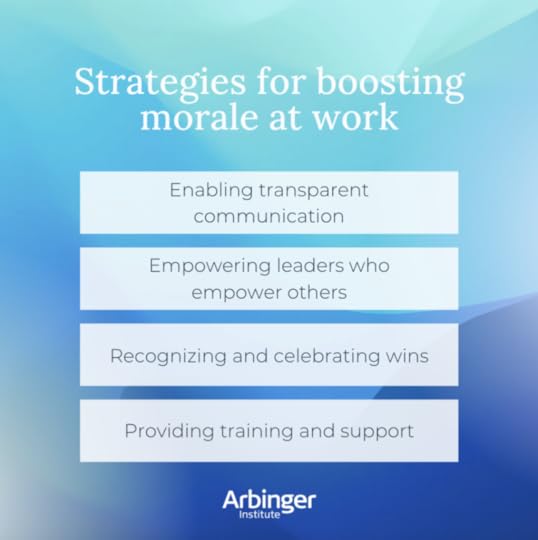 Examining real-world examples
Examining real-world examplesOne only needs to look to media headlines for examples of organizations that provide support to employees during hard times and foster resilience in the workplace, and those whose actions could use improvement—and sometimes drastic enhancement.
AirBnB is the perfect study in navigating hard times with both clarity and empathy. During the COVID-19 pandemic, the company had to make changes. The CEO’s letter to employees emphasized the value of all employees, regardless of their status post-layoff, and provided clear information about the situation and next steps, to further create an atmosphere of respect and certainty.
For those employees departing, he delivered options for them to maintain control over their profiles and work samples. And despite the layoffs, efforts were made to preserve a sense of connection and belonging at work. Additionally, the CEO transparently explained his decision-making process behind the layoffs to ensure fairness and to provide resources to affected employees. Overall AirBnB’s approach to this challenging time is underscored with human-centric communication in navigating challenging business decisions.
As a study in contrast, Elon Musk’s acquisition of Twitter (now known as X) involved significant workforce reductions and changes to company culture. The workforce reductions happened quickly, with some legal and contractual issues arising in the process. This led to a period of uncertainty for employees. The layoffs affected all levels of the company, including senior executives. Some employees resigned due to the changes, and there were reports of disagreements about how to follow company policies during the transition. Overall, the changes to Twitter’s workforce caused a period of adjustment for many employees.
Resilience in the workplace hinges on effectively managing morale during hard times. Transparent communication, empowering leadership, recognition of achievements, and provision of support and resources are key strategies essential for fostering and maintaining morale amid challenges like layoffs, budget cuts, and restructuring.
By prioritizing transparency, empowerment, recognition, and support, organizations can cultivate a culture of trust and collaboration, ensuring the well-being and morale of their workforce and emerging stronger in the face of adversity.
 hbspt.cta.load(23346030, 'bdeb1367-d9ea-4975-abcd-0eec52f20413', {"useNewLoader":"true","region":"na1"});
hbspt.cta.load(23346030, 'bdeb1367-d9ea-4975-abcd-0eec52f20413', {"useNewLoader":"true","region":"na1"}); The post Resilience in the workplace: Managing morale through difficult times appeared first on Arbinger.
April 10, 2024
DEI metrics: Measuring what matters for a more inclusive workplace
In today’s world of work, diversity, equity, and inclusion are no longer just buzzwords—they’re core values that are critical to any successful organization. Nurturing a diverse workforce with a culture of equity and inclusion has proven to drive innovation, employee engagement, and overall company performance. But when DEI metrics are perceived as particularly tricky to measure, it can be difficult to understand your success.
Just like you can’t improve what you don’t measure, you can’t create a truly inclusive workplace without data to guide your actions. This blog post will explore key DEI metrics and how to use them to build a more welcoming and successful organization.
Why measure DEI?“You can’t improve what you don’t measure” is especially true for your DEI initiatives. DEI metrics provide valuable data-driven insights into the progress you’re making toward a more inclusive workplace. These diversity metrics to track can be quantitative (numbers) or qualitative (descriptive). By tracking both types of data, you’ll gain a holistic understanding of your company’s DEI landscape.
Tracking DEI metrics empowers you to:
Track progress and spot areas for improvement: Just like with any goal, you need a way to measure if you’re making progress. DEI metrics provide hard data to show what’s working and where there might be gaps in your efforts to create a diverse and inclusive environment.
Be transparent and stay accountable: Having clear DEI goals and tracking metrics demonstrates a commitment to creating a more inclusive workplace. This transparency fosters trust among employees and shows everyone that DEI is a priority for the organization.
Make data-driven decisions: Instead of relying on hunches, DEI metrics allow you to base your decisions on real data. This ensures your initiatives are targeted towards the areas that will have the most significant impact on creating a more inclusive culture.
Improve employee engagement: When employees see the organization actively working to create a diverse and inclusive environment, they feel more valued and respected. This can lead to increased employee engagement, satisfaction, and ultimately, a high-performing culture.
Accelerate business outcomes: Research has shown that companies with strong DEI practices tend to be more innovative, profitable, and have a better reputation. By measuring DEI metrics, you can track the impact your efforts are having on your bottom line.
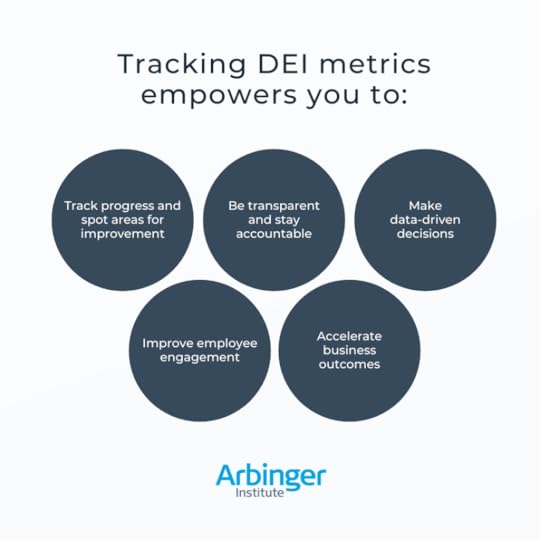 Key DEI metrics to track
Key DEI metrics to trackThere are several categories of DEI metrics to consider when evaluating your organization’s diversity, equity, and inclusivity. Here are some of the most important:
Representation metricsRepresentation metrics provide a snapshot of the diversity of your team across. Examples include:
Workforce demographics: Track the percentage of employees from different racial/ethnic backgrounds, genders, sexual orientations, and age groups.Hiring pipeline: Analyze the diversity of candidates throughout the recruitment process.By monitoring these metrics, you can identify areas where your recruitment efforts might need improvement to attract a more diverse pool of talent.
Equity metricsEquity metrics focus on ensuring fairness and equal opportunities for all employees. Some key examples include:
Pay equity analysis: Regularly assess compensation data to ensure there are no pay gaps based on demographics.Promotion rates: Analyze promotion rates across different employee groups to identify potential bias in advancement opportunities.These metrics can help you identify and address any systemic biases that might be hindering the progress of certain employee groups.
Inclusion metricsInclusion metrics assess how valued and respected employees feel within the organization.
While measuring inclusion can be challenging due to its subjective nature, there are ways to gather valuable data. Here are some examples:
Quantitative inclusion metrics:Employee Resource Group (ERG) participation: Track participation rates in ERGs as an indicator of employee engagement with diversity initiatives.Employee surveys: Conduct surveys to gauge employee sentiment on feeling valued, respected, and heard within the organization.Qualitative inclusion metrics:Focus groups: Host focus groups to gather in-depth feedback from employees about their experiences with inclusion.Exit interviews: Conduct exit interviews to understand why employees might be leaving and identify potential issues related to inclusion.By combining quantitative and qualitative data, you’ll get a deeper understanding of the full picture of your organization’s inclusion efforts.
Employee engagement metricsEmployee engagement is closely linked to DEI. When employees feel valued and respected, they’re more likely to be engaged and productive. Some relevant metrics include:
Employee satisfaction surveys: Conduct surveys to measure employee satisfaction with various aspects of work, including company culture and leadership.Retention rates: Analyze employee turnover rates to identify potential issues related to employee experience and inclusion.While not directly measuring inclusion, employee engagement metrics can indirectly reflect the overall success of your DEI initiatives because when employees feel psychologically safe and heard, they’re more likely to be engaged and participate at work.
Accessibility metricsAccessibility metrics assess the physical and technological barriers that might prevent employees with disabilities from fully participating in the workplace. Tracking these metrics ensures everyone has an equal opportunity to succeed. Here are some examples:
Physical accessibility: This includes metrics like the number of accessible workstations, accessible restrooms, and availability of assistive devices.Technology accessibility: Track the accessibility of your company software, internal communication platforms, and learning materials. Ensure they are compatible with screen readers, have closed captioning options for videos, and are navigable with keyboard controls.Accommodation requests: Monitor the number and types of accommodation requests received from employees with disabilities. Analyze trends to identify areas where accessibility improvements might be needed.By evaluating accessibility metrics as part of your DEI metrics to track, you demonstrate a commitment to creating an inclusive environment for all employees, regardless of ability.
Leadership and DEI metricsLeadership plays a critical role in fostering a culture of diversity, equity, and inclusion. Tracking metrics that demonstrate leadership’s commitment to DEI showcases its impact on the overall success of your initiatives. Here are some examples:
Leadership demographics: Track the diversity of your leadership team across various demographics. This reflects a commitment to diversity at all levels of the organization.Leadership training: Monitor participation rates in DEI training programs for leaders. This demonstrates investment in building leadership competency in fostering inclusion.Representation in decision-making: Analyze the diversity of leadership involved in key decision-making processes. This ensures diverse perspectives are considered and reflected in company decisions.By tracking leadership’s impact on DEI metrics, you can hold leadership accountable for driving a more inclusive workplace culture.
Putting DEI metrics into actionHaving the data is only the first step. To truly benefit from tracking DEI metrics, you need to put them into action. This involves:
Setting DEI goals: Use your metrics to establish clear goals for improving diversity, equity, and inclusion within your organization.Developing success plans: Create actionable plans to address any identified gaps in your DEI efforts.Continuous monitoring: Track your progress over time and adjust your strategies as needed. DEI is an ongoing process, not a one-time fix.DEI metrics are a powerful tool for any organization committed to creating a truly inclusive workplace. By tracking key diversity metrics and using data to guide your decisions, you can build a stronger, more innovative, and more successful organization.
 hbspt.cta.load(23346030, 'cbd92181-8746-4ff3-b1ab-f8b5905eca34', {"useNewLoader":"true","region":"na1"});
hbspt.cta.load(23346030, 'cbd92181-8746-4ff3-b1ab-f8b5905eca34', {"useNewLoader":"true","region":"na1"}); The post DEI metrics: Measuring what matters for a more inclusive workplace appeared first on Arbinger.
Arbinger Institute's Blog
- Arbinger Institute's profile
- 375 followers



